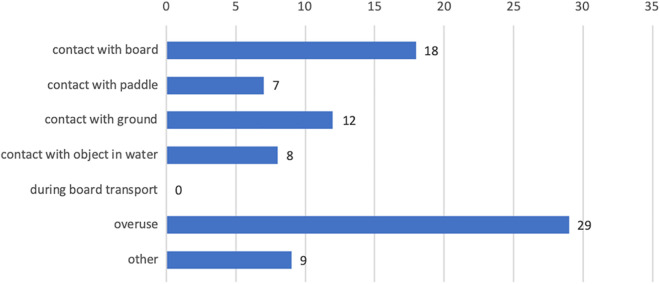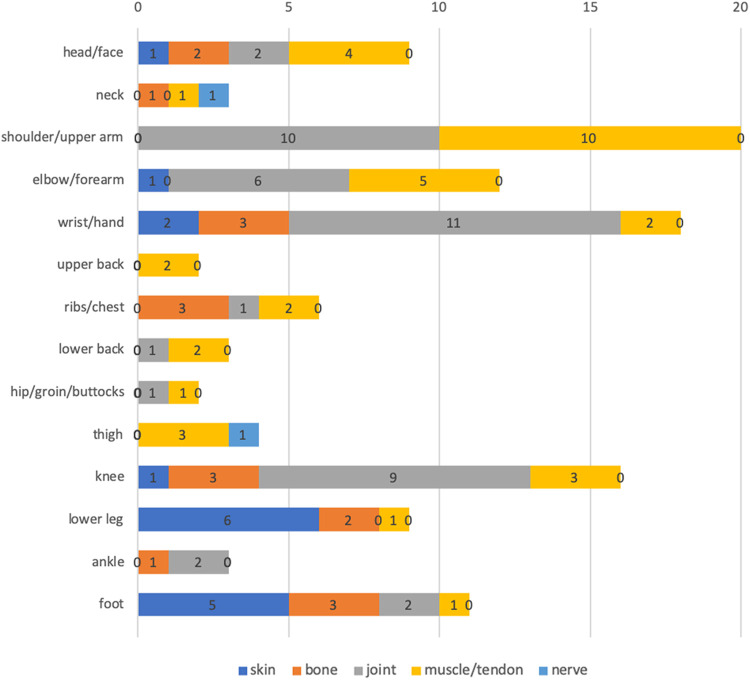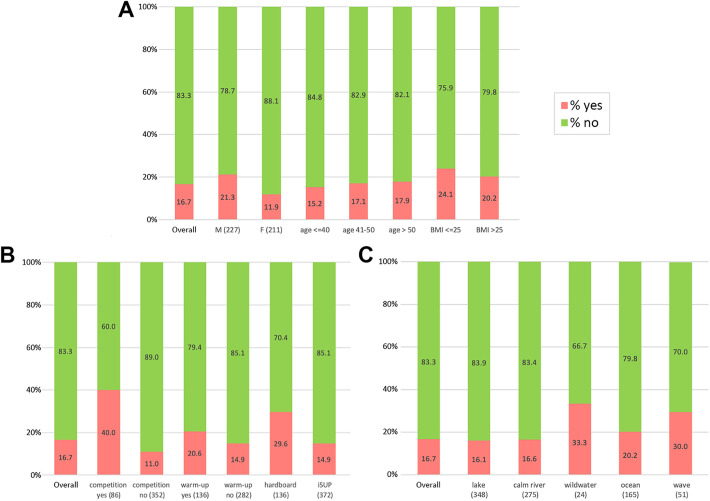Abstract
Background:
Stand-up paddleboarding (SUP) is a water sport that has gained in popularity. Still, very little is known about its injury profile.
Purpose:
To analyze the incidence, mechanisms, and risk factors for SUP-related injuries in mainly calm waters and the use of safety equipment.
Study Design:
Descriptive epidemiology study.
Methods:
The authors distributed an online survey that gathered information on characteristics, injury history over the past 12 months, use of (safety) equipment, and health issues of SUP riders in German-speaking countries.
Results:
A total of 438 participants completed the survey. The mean participant age was 45 years (range, 8-82 years), 48% were female athletes, and 19.6% took part in competitions. Over the past 12 months, 72 (17%) of 431 respondents experienced a SUP-related injury, resulting in an overall incidence rate (IR) of 1.95 injuries per 1000 hours of activity. Male competitive athletes using a hardboard had the highest risk of injury. The IR for competitive riders was higher (3.21 injuries per 1000 hours) than that for recreational riders (1.41 injuries per 1000 hours). Mechanisms of injury were overuse (n = 29) and contact with the board (n = 18) or ground (n = 12). Injuries affected mainly muscles/tendons and joints of the upper arm/shoulder (n = 20), followed by wrist/hand (n = 18), knee (n = 16), elbow/forearm (n = 12), and foot (n = 11). The highest risk of injury occurred when paddling in wild water (33.3%), followed by SUP surfing (29.4%), and the lowest risk occurred while paddling on a lake (16.1%). A life vest was always used by 27, depending on the situation by 201, and never by 202 participants; a leash was always used by 161, depending on the situation by 244, and never by 26 participants. Of the 272 participants who paddled in winter, 253 wore a drysuit or wetsuit, whereas 19 paddled without any special clothing.
Conclusion:
SUP-related injuries predominantly happened in wild water or while SUP surfing, and male competitive athletes using a hardboard had the highest risk of injury. The main mechanisms of injury were overuse and hitting the board or ground. The upper extremity was more prone to injury, followed by the knee and foot. More effort should be made to educate paddlers on the necessity and correct use of the life vest, leash, and specialized outfits.
Keywords: SUP, stand-up paddling, stand-up paddleboarding, injury epidemiology, sport injuries
Introduction
Stand-up paddleboarding (SUP) is a sport and recreational activity in which the athlete stands on a floating board using a paddle to move forward through the water. This sport has recently gained more popularity, especially since the invention of the inflatable stand-up paddleboard (iSUP). Originating in Hawaii, it is now practiced all over the world in various intensities and disciplines, ranging from recreational paddling on a calm lake or slow river to wild water paddling (Figure 1), open ocean or long-distance paddling, and SUP surfing in breaking waves.
Figure 1.
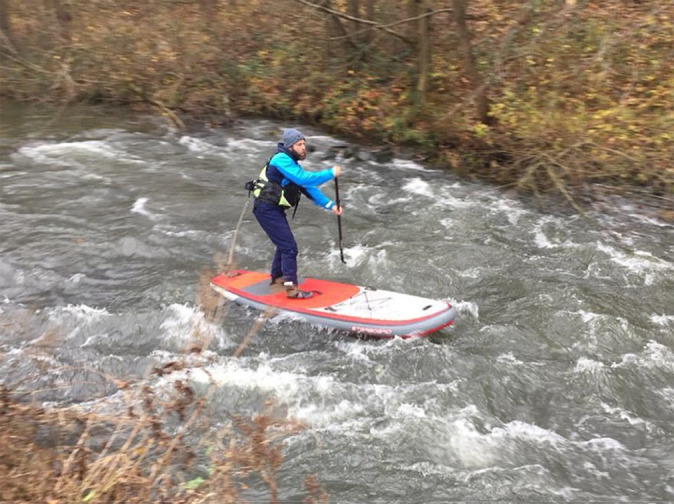
An athlete performing wild water stand-up paddleboarding.
SUP has attracted rising attention because of its ease of access; connection to nature; and proposed benefits in balance, strength, and overall fitness.16,15 Between 2010 and 2014, the population of stand-up paddlers in the United States increased from 1.1 million to 2.8 million.17
The literature provides data on injury epidemiology,2,4,6,8,11 but few studies have investigated the injuries or problems due to overuse specifically in SUP.3,18 Waydia and Woodacre,8 from Cornwall, conducted an interactive web-based survey among surfing clubs in the United Kingdom, with mainly surfers responding (31 stand-up paddleboarders and 144 surfers). Among the paddlers, 27% performed SUP surfing. Another online survey, published in 2017 by Furness et al,3 from Australia, collected information from 240 participants, of whom 28.3% performed SUP surfing, including injury history over the past 12 months.
So far, no study on the epidemiology of SUP-related injures with a focus on mainly flat water paddling has been published. Despite the increasing popularity of this activity, there are still no scientific data on the acceptance and usage of safety equipment such as a leash (string attaching the board to the rider) or life vest. Thus, the primary purpose of this study was to investigate the epidemiology of SUP-related injuries and corresponding risk factors in a large and heterogeneous group of stand-up paddlers mainly paddling on flat water. Additionally, the survey aimed to gather data on the usage and acceptance of safety equipment.
Methods
Research ethics approval was granted for the study protocol. An online survey was developed for German-speaking countries (Germany, Austria, Switzerland) via a professional survey platform (LimeSurvey). The survey consisted of 6 sections:
Characteristics: age, sex, height, weight, country, and profession
Intensity and frequency of training: years of experience, main reasons for participation, frequency and intensity of training, how participant got introduced to the sport, preferred environment (eg, sea, river, ocean), and participation in competitions
SUP and safety equipment: type and price of SUP board, use of leash and/or life vest, SUP pump, and SUP in winter
Injuries: performance of warm-up, injuries during the last 12 months, affected body part, type and severity of injury, mode and circumstances of injury, and commentaries for owners of a SUP school
Dietary and health habits: consumption of meat, fruits, vegetables, alcohol, and cigarettes, and 6 main topics
Other comments
Participants and Distribution of Survey
The survey was pilot tested by a physician, physical therapist/osteopath, and SUP coach as well as 5 paddlers to ensure the practicability and relevance of the included questions. Any person, regardless of age, who performed SUP over the last 12 months was allowed to take part in the online platform, which was available between October 2019 and March 2020. The survey was distributed on different SUP-related Facebook Inc. sites in the German language (SUP Deutschland, SUP Germany, SUP Cologne Bonn, SUP sport, Sup.de, SUP spirit, SUP online academy, SUP-mag.de, Standuppaddeln.at, SUPScout, German SUP challenge, SUP Trip, SUP Station Koblenz, SUP Verleih Köln, Deutscher Stand Up Paddle Verband, SUPvienna, Stand Up Magazin, SUP Deutschland – board meeting, Paddel-Station, GREENPaddle). Paddlers who did not sustain any injury were also asked to take part in the survey.
Injury Definitions
To evaluate the incidence of injuries and to enable comparison with other studies, the incidence rate (IR) and incidence proportion (IP) were used.7 IR was calculated by dividing the total number of injuries by the total hours of activity within the previous 12 months and indicates the rate of injury per unit of exposure. IP was calculated by dividing the number of injured athletes by the total number of athletes at risk during the previous 12 months and indicates the risk of injuries. To enable calculation, total hours were converted to 1000 by dividing the total number of injuries by 1000 hours of activity.
Data Analysis
Data were analyzed using Excel Version 16.16.25 (Microsoft Corp). Variables were summarized using frequencies and descriptive statistics. All calculations were based on the participants’ reports. Age, height, and weight, presented as means and ranges, were calculated in total and separately for male and female participants. Age distribution was described by subdividing participants into 9 groups (0-10, 11-20, 21-30, 31-40, 41-50, 51-60, 61-70, 71-80, and 81-90 years). Participants selected their preferred environment (lake, slow river, ocean, surfing, wild water), main paddling motivation, injury mechanism, injury location, and type of injury out of multiple options, from which frequencies were then calculated. These answers were used to calculate the percentage of injured riders by category (eg, from the 24 participants who paddled in wild water, 8 reported at least 1 injury, resulting in a rate of 33.3% injured wild water riders). Finally, participants were grouped by sex (male, female), age (≤40, 41-50, >50 years), body mass index (BMI; ≤25, >25), participation in competition (yes/no), performing warm-up (yes/no), and type of board (hardboard, iSUP). For each group, the percentage of injured riders was calculated.
Results
A total of 535 participants started the survey, and 438 completed it. Ninety-five participants did not provide adequate information after the characteristics section and were excluded from further evaluation. The majority of individuals (n = 421/535) was from Germany, followed by Switzerland (n = 12) and Austria (n = 11), and 1 participant each was from Liechtenstein, Netherlands, France, and “Mediterranean Sea.” Eighty-seven did not answer the question regarding their country.
Participant Characteristics
Of the participants, 211 (48%) were women and 227 (52%) were men. The mean age was 45 years (range, 8-82 years). The age distribution of the participants is shown in Figure 2. The mean height was 176 cm; mean weight, 77 kg; and mean BMI, 25. A total of 86 participants (19.6%) indicated they take part in competitions (n = 74 long distance, 40 sprint races, 8 wild water, 5 SUP surfing, and 9 other; multiple answers were allowed). Women were slightly younger, smaller, lighter, and less competitive compared with men (Table 1).
Figure 2.
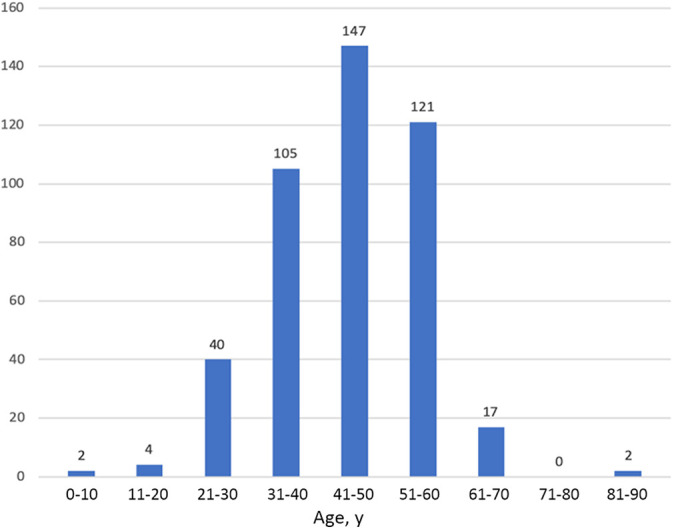
Age distribution of the study participants.
TABLE 1.
Physiological Characteristics by Sexa
| Total (N = 438) | Women (n = 211) | Men (n = 227) | |
|---|---|---|---|
| Age, y | 45 (8-82) | 43 (8-82) | 45 (9-68) |
| Height, cm | 176 (128-202) | 169 (128-193) | 182 (149-202) |
| Weight, kg | 77 (22-133) | 68 (22-104) | 86 (31-133) |
| BMI | 25 (13-37) | 24 (13-36) | 26 (14-37) |
| Participate in competitions, n (%) | 86 (19.6) | 26 (12.3) | 60 (26.4) |
aData are reported as mean (range) unless otherwise indicated. BMI, body mass index.
Sixty-seven participants had participated in the sport for <1 year; 103 participants, 1 to 2 years; 106 participants, 3 to 4 years; 57 participants, 4 to 5 years, and 105 participants, >5 years. More than half of the respondents (n = 227) started SUP on their own; 144, with taking classes at a SUP school; 50, with advice from an experienced friend; and 17, in some other way. Most participants preferred paddling on a lake (n = 348), a slow river (n = 275), or the ocean (n = 165). Fifty-one participants performed SUP surfing, and 24 performed wild water SUP. The main motivations for performing this activity (multiple answers were allowed) were “nature experience” (n = 347), “fitness” (n = 325), and “staying healthy” (n = 241), followed by “just for fun” (n = 223), “training” (n = 193), “play and family” (n = 86), and “competition” (n = 68).
Injury IR and IP
Of 431 respondents, 72 (17%) recalled SUP-related injuries within the past 12 months, whereas 359 (83%) did not. From these 72, 50% needed to see a physician, and 20% were not able to go to work. Twenty-two percent had injury-related problems for “days”; 43%, for “weeks”; and 33%, for “months.”
The injury IR and IP are shown in Table 2. The overall IR for all participants was calculated to be 1.95 injuries per 1000 hours of activity, and the IP for all participants was calculated to be 0.16 injuries per rider per 12 months. Both the IR and IP were higher for competitive compared with recreational SUP riders (Table 2).
TABLE 2.
Injury Incidence Rate and Incidence Proportion (N = 431 Respondents)
| Injured | Not Injured | Incidence Rate, Injuries/1000 h | Incidence Proportion, No. of Injured Riders/All Riders | |
|---|---|---|---|---|
| Recreational (n = 346) | 38 | 308 | 1.41 | 0.11 |
| Competitive (n = 85) | 34 | 51 | 3.21 | 0.4 |
Mechanism, Location, and Type of Injury
Overuse injuries were reported by the largest number of paddlers (n = 29), followed by contact with the board (n = 18) or ground (n = 12) (Figure 3). Thirty-seven injuries occurred during recreational activities; 26, during training or competition; 16, while touring; and 4, while performing other activities. Overall, 82 injuries happened to 71 participants. Thirty-eight participants were injured while paddling on calm waters like a lake; 18, on flowing waters like a river (8 of which were in wild water); and 15, while surfing on waves. The largest number of participants (n = 348) primarily paddled on calm waters, followed by rivers (n = 299, 24 of which were wild water) and waves (n = 51).
Figure 3.
Mechanism of injury.
An overview of the location and type of injury is presented in Figure 4. The most commonly injured body region was the upper arm/shoulder (n = 20), followed by the wrist/hand (n = 18), knee (n = 16), elbow/forearm (n = 12), and foot (n = 11). The most frequent types of injury were overuse (n = 29), “other” (n = 18), contusion (n = 17), and strain (n = 14), mainly affecting muscles/tendons and joints. Notably, 10 participants reported having had a fracture.
Figure 4.
Location and type of injury.
Injury Risk Factors
Male SUP riders had a higher frequency of injuries (21.3%) than did female riders (11.9%), and older age was associated with slightly more injuries (15.2% for age <40 years vs 17.1% and 17.9% for ages 41-50 and >50 years, respectively) (Figure 5A). A warm-up routine before paddling was regularly performed by 136 participants (31%), and participants performing a warm-up routine recalled a higher percentage of injuries (20.6%) than did those who did not warm up (14.9%). Riders participating in competition were more frequently injured (40.0%) than were recreational riders (11.0%), and a higher percentage of injuries was reported when using a hardboard (29.6%) compared with using an iSUP (14.9%) (Figure 5B). The highest percentage of injured riders was calculated for wild water (33.3%), followed by SUP surfing (30.0%). The least hazardous was paddling on a lake (16.1%) (Figure 5C). Only a few injuries were reported by beginners with less than 1 year of paddle experience (7.7%), compared with more experienced paddlers (1-2 years, 15.8%; 3-4 years, 18.4%; 4-5 years, 15.8%; >5 years, 21.9%).
Figure 5.
Percentage of participants with at least 1 injury, stratified by (A) participant characteristics; (B) level of competition, warm-up routine, and type of board; and (C) preferred environment. BMI, body mass index; F, female; iSUP, inflatable stand-up paddleboard; M, male.
Equipment and Safety Behavior
A total of 372 participants owned an iSUP; 136, a hardboard. Preferred board types (some owned several boards) were “all-round” (n = 230), “tour” (n = 222), “race” (n = 110), “wave” (n = 61), and “wild water” (n = 21). Boards were mostly bought in a “specialized shop” (n = 267), followed by “online” (n = 105), “secondhand” (n = 87), “discounter” (n = 12), or “other” (n = 32). A total of 266 preferred a mechanical pump; 114, an electrical pump. Concerning the use of a life vest, 27 indicated that they “always” wear one, 202 “never” wear one, and 201 wear a vest “depending on the situation.” A leash was “always” used by 161 participants, “never” used by 26, and used “depending on the situation” by 244. A total of 257 “always attached the leash to the leg” (slow river, n = 141; wild water, n = 2); 50, “always to a belt” (slow river, n = 41; wild water, n = 7); and 102 attached the leash either to the leg or belt “depending on the situation” (slow river, n = 77; wild water, n = 15). The majority (n = 272) also paddled in the wintertime, whereas 152 participants did not. From these 272, most (n = 161) wore a drysuit or wetsuit (n = 92). Nineteen paddled in winter without any special wetsuit or drysuit.
Health and Dietary Habits
The majority (n = 353) of stand-up paddlers were nonsmokers, 29 smoked <10 cigarettes per day, and 41 smoked >10. In general, the stand-up paddlers in our survey led a healthy lifestyle, with only few claiming alcohol and meat consumption, and indicated a regular intake of fruits and vegetables (Figure 6). A total of 214 participants regularly collected garbage that was lying around in nature while paddling, 211 did not, and 13 did not respond.
Figure 6.
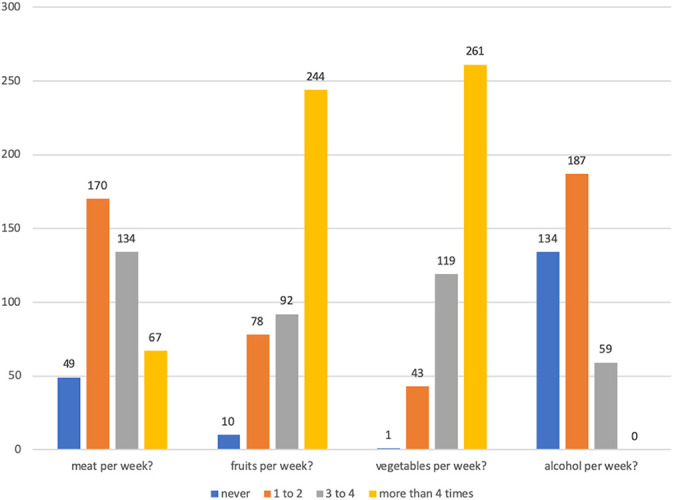
Dietary habits of participants.
Discussion
The participants of the present study were rather healthy women and men, at a mean age of 45 years, performing SUP mainly for the sake of the nature experience and fitness. Among participants, the SUP disciplines with the highest percentage of injured riders were wild water SUP and SUP surfing. The most commonly reported mechanism of injury was overuse or hitting the board or ground. Competition paddlers indicated a higher percentage of injuries than did recreational paddlers. The same can be said for older and male paddlers among participants, as well as the use of a hardboard compared with an iSUP.
In the study by Waydia and Woodacre,18 all SUP-related injuries happened while SUP surfing, mainly from impact with their own paddleboard, which is in accordance with our findings. However, only 31 stand-up paddlers answered their survey.18 The biggest survey so far, with 240 participants, and the only one focusing exclusively on SUP-related injuries was published by Furness et al3 in 2017. A high percentage (28.3%) predominantly performed SUP surfing. This might explain their higher IR of 3.63 injuries per 1000 hours of SUP versus 1.95 injuries per 1000 hours of SUP in the present study and the higher IP of 0.41 versus 0.16. Our data support the findings of Waydia and Woodacre18 and Furness et al3 that SUP surfing is significantly more dangerous than is SUP in calm waters. Since in our study the rate of participants predominantly performing SUP surfing was low, the overall injury rate, the IP and IR, respectively, was lower. What our findings add to the existing findings in the literature is that SUP in wild water is even more dangerous than is SUP surfing. So far there are no data on this specific discipline available in the literature. Wild water SUP is typically performed on a short and wide iSUP. Because of the turbulent water, falls are common, and the likelihood of hitting the ground and getting injured is high. The data of Furness et al3 that injury rate is affected by older age, competitive status, and longer hours of participation are also supported by our study. As in the study by Furness et al,3 the main mechanism of injury was overuse or endurance paddling, mainly affecting muscles or joints. Concerning the published injury rate of almost 50% in competitive SUP riders over a 1-year period, we also found a clearly higher injury rate of 40% in competitive riders compared with 11% in recreational riders. This reveals the higher strain that intensive SUP puts on the athlete’s body. The IR of 3.21 injuries per 1000 hours in competitive SUP riders in our study is almost identical to the rate found by Furness et al3 (3.29 injuries per 1000 hours) and is thus higher than that in competitive surfers.2 This is remarkable because surfing is a strenuous sport with high physical demands. It might be explained by the fact that in surfing only 5% of the time is actually spent riding waves,9 whereas in SUP the athlete is constantly moving. Minghelli et al10 published that the highest percentage of surfing injuries (27.1%) are caused by contact with the board. Thus, the bigger and heavier construction of SUP boards compared with surfboards might also be responsible for the higher injury rate. Compared with other extreme water sports such as wind surfing (IP, 1.9), kite surfing (IR, 7 injuries per 1000 hours), and cable wakeboarding (IR, 12 injuries per 1000 hours), SUP is substantially less dangerous.12–14
As expected, based on the study by Furness et al3 and data on other watersports, such as kayaking1 and surfing,2 the shoulder/upper arm was the most injured body part. Also, the high frequency of injuries to the elbow and forearm2,3 can be confirmed by our data. Contrary to Furness et al,3 we found substantially more injuries to the hand/wrist, knee, and foot but rarely to the low back. Because of the specific paddle technique, the upper extremity is put under a constantly high strain, which might explain the higher rate of injuries in this region. The reasons why the low back was hardly affected in our participants remain unclear. We would have expected a significantly higher injury rate as a result of the exposure of the low back to high impact transferred from the feet to the arms, as found by Furness et al.3 It might at least in part be explained by the higher rate of recreational paddlers in our study, who might put less strain on their low back while paddling. Other factors contributing to the high incidence of shoulder, elbow, and wrist injuries might be a poor paddling technique or poor paddle material. Keeping in mind that SUP is likely to be an Olympic sport in the near future, there is a need for biomechanical studies identifying and modifying paddle technique as well as material of the paddle. Interestingly, in our study, a warm-up routine was associated with a higher injury rate.5 This finding is most likely a confounding bias due to the fact that paddlers participating in competition typically use hardboards and also warm up.
Rare but fatal SUP incidents such as drowning could easily be prevented by correct use of safety equipment such as a leash, life vest, and wet- or drysuit. The presented data help to promote the necessity of safety equipment and explain its correct use. Although the majority of participants (n = 228) indicated that they wear a life vest, there is still a large proportion (n = 202) who never wear one. Assuming that these people might also paddle on a river, a large lake, or the open ocean, they might be at a preventable risk. The same can be said for the use of a leash; although the majority (n = 270) mostly use a leash, some might not be aware of hazards caused by wrong attachment to the body. Whereas on a lake or ocean the attachment of the leash to the leg is absolutely correct, it might endanger a paddler in flowing waters such as a slow river (n = 141 to the leg) or even a wild water (n = 2 to the leg). In these cases, a leash belt with a quick release is recommended to prevent drowning by being stuck in currents in case of the leg leash becoming tangled around an object (eg, buoy or identification mark) in the water. Another easily preventable danger is exposing oneself to extreme weather conditions, namely cold. Nineteen participants indicated that they paddle in the winter without using any special dry- or wetsuit. They need to be educated on the extreme risks of drowning in cold water.
The study design of a retrospective online survey is susceptible to bias. Participants might not accurately remember their injuries sustained within the time frame of the last 12 months. Another limitation is the procedure of self-reporting of injuries, which might not be as accurate as a report by a health professional. Also, the study population might not represent the overall popularity of performing stand-up paddling (participation bias). Riders who have sustained an injury might have been more willing to participate compared with riders without an injury. Moreover, competitive athletes might be more willing to participate compared with recreational paddlers. This might explain the high rate of competitors in our study and former studies. This bias is likely to be magnified by the distribution of the survey mainly via social media. In these groups, predominantly paddlers who consider SUP a serious sporting activity are active. Thus, the large and growing proportion of recreational paddlers without any sportive ambition is underrepresented by the present study. This is confirmed by the fact that only 12 of all participants bought their SUP at a discounter. This differs from the experiences every ambitious paddler has at their local SUP spot with many inexperienced paddlers on “discount” boards. Therefore, the results of the present study are only specific for ambitious SUP riders and might not be generalized for the whole SUP population. Additionally, the survey was isolated to 1 language, and the data may not be extrapolated to a wider population of SUP athletes.
Despite these limitations, the present study adds relevant information on injuries and risk factors in stand-up paddling, not only in the waves but also in calm waters. Additionally, this is the first study to specifically address the discipline of wild water SUP and evaluate the use of safety equipment.
Conclusion
SUP-related injuries predominantly happened in wild water or while SUP surfing, whereas paddling on a calm lake or slow river was less risky. Male competitive athletes using a hardboard were more likely to experience an injury compared with female recreational paddlers using an iSUP. The main mechanisms of injury were overuse and contact with the board or ground. The upper extremities were more prone to injury, followed by the knee and foot. Primarily muscles/tendons and joints were affected. There is a need for biomechanical studies to analyze and optimize paddle technique and paddle material. In this study, stand-up paddleboarders were mainly healthy individuals who largely use safety equipment. However, more efforts have to be made to educate paddlers on the necessity and correct use of a life vest, a leash, and specialized clothes.
Footnotes
Final revision submitted February 2, 2021; accepted February 25, 2021.
The authors declared that they have no conflicts of interest in the authorship and publication of this contribution. AOSSM checks author disclosures against the Open Payments Database (OPD). AOSSM has not conducted an independent investigation on the OPD and disclaims any liability or responsibility relating thereto.
Ethical approval for this study was obtained from the University of Witten/Herdecke Ethics Committee (131/2019).
References
- 1.Fiore DC, Houston JD. Injuries in whitewater kayaking. Br J Sports Med. 2001;35(4):235–241. [DOI] [PMC free article] [PubMed] [Google Scholar]
- 2.Furness J, Hing W, Walsh J, et al. Acute injuries in recreational and competitive surfers: incidence, severity, location, type, and mechanism. Am J Sports Med. 2015;43(5):1246–1254. [DOI] [PubMed] [Google Scholar]
- 3.Furness J, Olorunnife O, Schram B, Climstein M, Hing W. Epidemiology of injuries in stand-up paddle boarding. Orthop J Sports Med. 2017;5(6):2325967117710759. [DOI] [PMC free article] [PubMed] [Google Scholar]
- 4.Griffin AR, Perriman DM, Neeman TM, Smith PN. Musculoskeletal injury in paddle sport athletes. Clin J Sport Med. 2020;30(1):67–75. [DOI] [PubMed] [Google Scholar]
- 5.Herman K, Barton C, Malliaras P, Morrissey D. The effectiveness of neuromuscular warm-up strategies, that require no additional equipment, for preventing lower limb injuries during sports participation: a systematic review. BMC Med. 2012;10:75. [DOI] [PMC free article] [PubMed] [Google Scholar]
- 6.Kerr ZY, Baugh CM, Hibberd EE, et al. Epidemiology of National Collegiate Athletic Association men’s and women’s swimming and diving injuries from 2009/2010 to 2013/2014. Br J Sports Med. 2015;49(7):465–471. [DOI] [PMC free article] [PubMed] [Google Scholar]
- 7.Knowles SB, Marshall SW, Guskiewicz KM. Issues in estimating risks and rates in sports injury research. J Athl Train. 2006;41(2):207–215. [PMC free article] [PubMed] [Google Scholar]
- 8.McCormick DP, Davis AL. Injuries in sailboard enthusiasts. Br J Sports Med. 1988;22(3):95–97. [DOI] [PMC free article] [PubMed] [Google Scholar]
- 9.Meir RA, Lowdon BJ, Davie AJ, Geebng DU, Victoria A. Heart rates and estimated energy expenditure during recreational surfing. Aust J Sci Med Sport. 1991;23(3):70–74. [Google Scholar]
- 10.Minghelli B, Nunes C, Oliveira R. Injuries in recreational and competitive surfers: a nationwide study in Portugal. J Sports Med Phys Fitness. 2018;58(12):1831–1838. [DOI] [PubMed] [Google Scholar]
- 11.Nathanson A, Haynes P, Galanis D. Surfing injuries. Am J Emerg Med. 2002;20(3):155–160. [DOI] [PubMed] [Google Scholar]
- 12.Nickel C, Zernial O, Musahl V, et al. A prospective study of kitesurfing injuries. Am J Sports Med. 2004;32(4):921–927. [DOI] [PubMed] [Google Scholar]
- 13.Patzer T, Hrabal SA, Timmesfeld N, Fuchs-Winkelmann S, Schofer MD. Incidence and mechanism of injuries in cable-wakeboarding: a prospective study. Article in German. Sportverletz Sportschaden. 2009;23(3):141–147. [DOI] [PubMed] [Google Scholar]
- 14.Petersen W, Rau J, Hansen U, Zantop T, Stein V.Mechanisms and prevention of windsurfing injuries. Article in German. Sportverletz Sportschaden. 2003;17(3):118–122. [DOI] [PubMed] [Google Scholar]
- 15.Schram B, Hing W, Climstein M. Profiling the sport of stand-up paddle boarding. J Sports Sci. 2016;34(10):937–944. [DOI] [PubMed] [Google Scholar]
- 16.Schram B, Hing W, Climstein M. The physiological, musculoskeletal and psychological effects of stand up paddle boarding. BMC Sports Sci Med Rehabil. 2016;8:32. [DOI] [PMC free article] [PubMed] [Google Scholar]
- 17.Special Report on Paddlesports. The Outdoor Foundation; 2015. [Google Scholar]
- 18.Waydia SE, Woodacre T. Paddle-boarding: fun, new sport or an accident waiting to happen? Trauma Mon. 2016;21(3):e19299. [DOI] [PMC free article] [PubMed] [Google Scholar]



